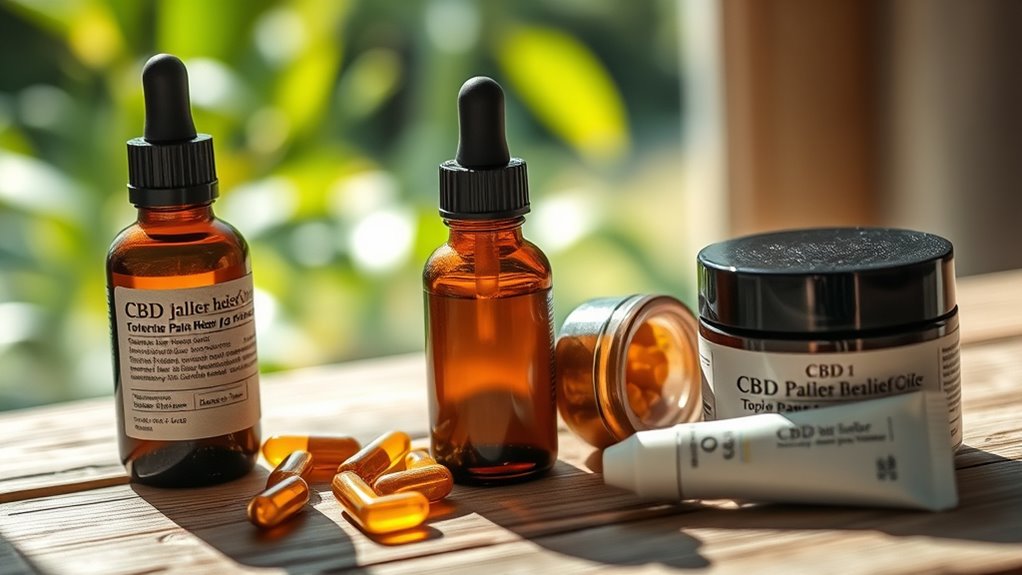CBD offers hope for natural pain relief by reducing inflammation and easing discomfort for many users, with fewer side effects than traditional medications. However, its effectiveness varies based on individual factors, product quality, and dosage. While some see promising results, scientific studies are still exploring its full potential. If you want to learn how to safely and effectively incorporate CBD into your pain management routine, there’s more to discover ahead.
Key Takeaways
- CBD may reduce pain and inflammation, offering a potential natural alternative when used consistently and with quality products.
- Scientific evidence is promising but still limited; more research is needed to confirm CBD’s effectiveness for chronic pain.
- Proper dosing, product quality, and individual response significantly influence CBD’s pain-relieving benefits.
- CBD is generally safe when sourced from reputable providers, but legal status varies by region.
- CBD should be part of a broader pain management strategy, not relied upon as a standalone cure.

Are you tired of relying solely on traditional pain medications that often come with unwanted side effects? If so, you might be exploring alternatives like CBD for chronic pain. Many people turn to cannabidiol because they’ve heard it offers relief without the harsh side effects associated with opioids or NSAIDs. But before you embark on this journey, it’s important to understand the safety aspects and legal considerations surrounding CBD use. CBD safety is a common concern, and while most users tolerate it well, it’s necessary to source it from reputable providers to guarantee quality and purity. Poorly manufactured products can contain contaminants or unintended THC levels, which could cause adverse effects or legal issues. Always look for products that provide third-party lab testing results, confirming their safety and potency.
Legal considerations are equally crucial when exploring CBD for pain relief. The laws surrounding CBD vary by state and country, and regulations are still evolving. In some regions, CBD derived from hemp containing less than 0.3% THC is legal, but it’s imperative to verify local laws before purchasing or using it. Being aware of the legal landscape helps you avoid potential legal trouble and make certain you’re making informed choices. Additionally, if you’re on other medications or have underlying health conditions, consult your healthcare provider to determine if CBD is a safe option for you. Some drugs may interact with CBD, affecting their effectiveness or causing unintended side effects. It’s also helpful to understand the different types of CBD products available, such as vetted – Grobal World options, to ensure you select high-quality, safe options.
Using CBD for chronic pain isn’t about instant cures; it’s a process that requires careful consideration and patience. Many users report a reduction in pain and inflammation, but results can vary depending on the individual, the dosage, and the quality of the product. It’s wise to start with a low dose and gradually increase until you find what works best for you. Remember, CBD isn’t a miracle cure, but it can be a helpful part of a broader pain management strategy. Keep in mind that research is ongoing, and while anecdotal evidence is promising, scientific studies are still exploring its full potential.
Frequently Asked Questions
Are There Any Long-Term Risks Associated With CBD Use?
You might wonder about long-term safety and dependence potential when using CBD. While current research suggests CBD is generally safe, long-term effects aren’t fully understood yet. You shouldn’t expect significant dependence issues, but it’s wise to monitor your use and consult with a healthcare professional if you plan to use CBD long-term. Staying informed helps you make safe choices and minimizes potential risks associated with prolonged use.
How Does CBD Compare to Traditional Pain Medications?
Imagine a dance between relief and risk—CBD’s efficacy in pain management strategies often rivals traditional meds. You’ll find CBD tends to have fewer side effects, making it appealing for those seeking natural options. While opioids and NSAIDs work quickly, they come with long-term risks. CBD offers a gentler approach, but it may take longer to see results. Weigh your options carefully; your pain management approach should balance effectiveness and safety.
Can CBD Be Used Alongside Other Pain Treatments Safely?
You can use CBD alongside other pain treatments, but you should be cautious about drug interactions. Always check for potential interactions with your medications and consult your healthcare provider. Maintaining dosage consistency is key to safety and effectiveness. While CBD may complement your pain management plan, monitoring how your body responds helps prevent adverse effects. Never adjust dosages or combine treatments without professional guidance to make certain of safe, effective relief.
What Are the Best Methods for Consuming CBD for Pain Relief?
Imagine you’re exploring CBD for pain relief and wonder about consumption methods. You might try sublingual oils, which offer quick absorption. Always follow dosage guidelines to guarantee safety. For some, capsules provide a discreet option, while topicals target localized pain effectively. Your choice depends on your needs and preferences. Experiment with different methods, but consult a healthcare professional to determine the best approach tailored for you.
Is CBD Effective for All Types of Chronic Pain?
You might wonder if CBD works for all types of chronic pain. While some users report relief, effects vary due to factors like cannabis interactions and individual differences. Keep in mind, placebo effects can influence perceived benefits. CBD may help with certain conditions, but it isn’t a universal remedy. Always consult a healthcare professional to understand how it might fit your specific pain management needs.
Conclusion
So, is CBD the solution you’ve been searching for? Or just another hype? It’s worth exploring, worth considering, and worth talking to your doctor about. Because, after all, your pain relief should be safe, natural, and effective. CBD offers hope, invites questions, and demands caution. Whether you see it as a remedy or a risk, remember to stay informed, stay cautious, and stay proactive in managing your chronic pain. Your health, your choice, your journey.










